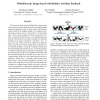CVPR
2012
IEEE
12 years 2 months ago
2012
IEEE
We propose a novel mode of feedback for image search, where a user describes which properties of exemplar images should be adjusted in order to more closely match his/her mental m...
CVPR
2012
IEEE
12 years 2 months ago
2012
IEEE
Active learning aims to reduce the amount of labels required for classification. The main difficulty is to find a good trade-off between exploration and exploitation of the lab...
CVPR
2012
IEEE
12 years 2 months ago
2012
IEEE
In many vision problems, rotation-invariant analysis is necessary or preferred. Popular solutions are mainly based on pose normalization or brute-force learning, neglecting the in...
CVPR
2012
IEEE
12 years 2 months ago
2012
IEEE
In this work we seek to move away from the traditional paradigm for 2D object recognition whereby objects are identified in the image as 2D bounding boxes. We focus instead on: i...
CVPR
2012
IEEE
12 years 2 months ago
2012
IEEE
We present a unified occlusion model for object instance detection under arbitrary viewpoint. Whereas previous approaches primarily modeled local coherency of occlusions or attem...
CVPR
2012
IEEE
12 years 2 months ago
2012
IEEE
Despite much research on patch-based descriptors, SIFT remains the gold standard for finding correspondences across images and recent descriptors focus primarily on improving spe...
CVPR
2012
IEEE
12 years 2 months ago
2012
IEEE
We consider the problem of minimum distortion intrinsic correspondence between deformable shapes, many useful formulations of which give rise to the NP-hard quadratic assignment p...
CVPR
2012
IEEE
12 years 2 months ago
2012
IEEE
We present a model and an algorithm to detect salient regions in video taken from a moving camera. In particular, we are interested in capturing small objects that move independen...
CVPR
2012
IEEE
12 years 2 months ago
2012
IEEE
Locally Orderless Tracking (LOT) is a visual tracking algorithm that automatically estimates the amount of local (dis)order in the object. This lets the tracker specialize in both...
CVPR
2012
IEEE
12 years 2 months ago
2012
IEEE
The problem of multi-target tracking is comprised of two distinct, but tightly coupled challenges: (i) the naturally discrete problem of data association, i.e. assigning image obs...


